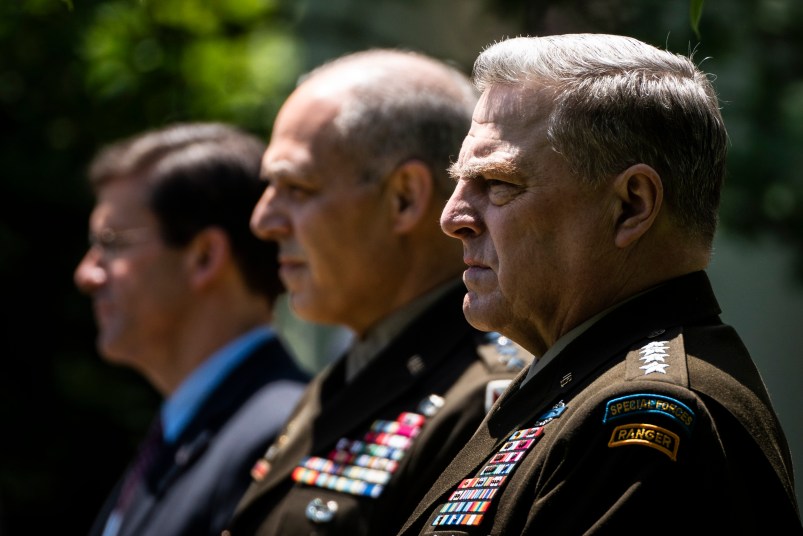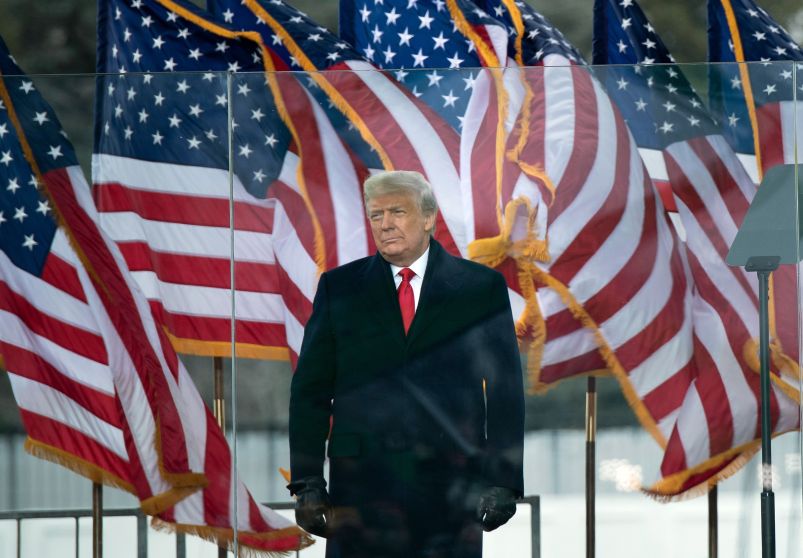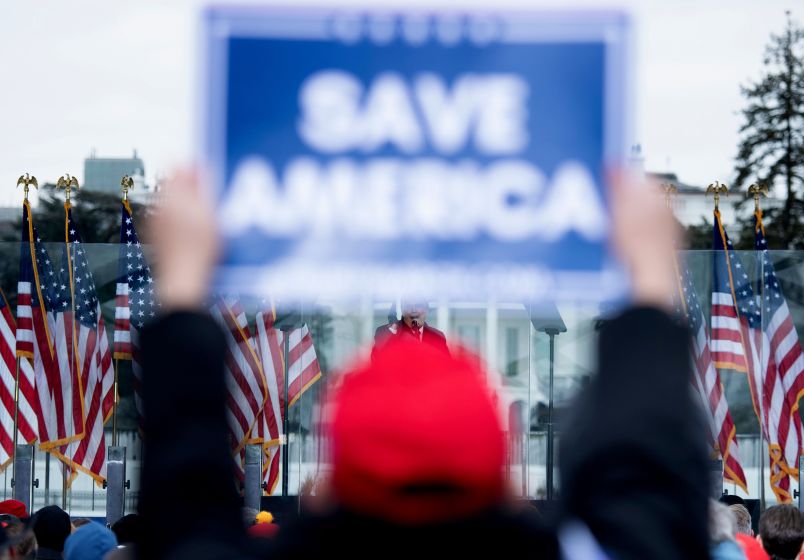Many MAGA influencers have an apocalyptic story to tell about the country, the political divide, and where we’re all headed, and they’re already using it to lay the groundwork for crossing what has long been a red line: deploying the military for domestic law enforcement purposes.
In this MAGA fever dream, everyone has their part to play. They believe that they’ll be caught up in it; you might be, too. It goes something like this: If Donald Trump wins in November, people will protest. Riots will break out. The left, they theorize, will go all-out to stoke organized violence around the country, clearing the way for a newly inaugurated Trump administration to step in and make unprecedented, widespread use of the U.S. military to restore law and order.
This dark vision of the future draws on deeply pessimistic theorizing, on lectures about Marxist anti-government ideology seemingly ripped from the Cold War, on memories of the Black Lives Matter protests in 2020, and on claims that Democrats and the left will be unable to accept a Trump victory. It all comes against the backdrop of senior officials around Trump and Trump himself reportedly having been eager to invoke the Insurrection Act while he was in office, and mulling its actual use if he’s re-elected.
In this situation, a second Trump administration would invoke the law to deploy the military to enforce immigration laws as part of a broader mission at the southern border — a proposal Trump has often spoken about publicly. But it would also make that invocation to do something far more extreme and at odds with American history: use the military against protestors.

Wargames
For this story, TPM spoke with influential right-wingers and reviewed publications, public statements, and planning documents from Trump-affiliated think tanks. They presented a vision of a Trump victory in the 2024 election that, in their telling, would almost immediately be followed by street fighting and mass violent protests aimed at destabilizing the new administration.
It’s all feverish: Several people TPM interviewed predicted that “people will die;” others imagined foreign control of their opponents and Marxist infiltration. Through it all ran an unwillingness to distinguish between peaceful protest and the employment of violence.
“If you see a peaceful protest from the left, please call me, because it’ll be the first time I’ve ever seen that,” Mike Howell, executive director of the Heritage Foundation’s Oversight Project, told TPM.
Howell, who served in the Department of Homeland Security during the Trump administration, helped direct a wargame that the Heritage Foundation ran simulating the 2024 election. Apart from preemptively dismissing the prospect of a fair election, the report suggested that readers should “expect public violence from left-aligned entities in the event of disfavored outcomes,” while warning that “biased media outlets” would minimize and understate the severity of that violence.
Howell laid out a similar, extended scenario to TPM: an outgoing Biden administration and the press would ignore mass violence, he said.
“I think people are going to die and I think they’ll excuse it,” Howell told TPM. “And I think it’s awful and I think we should be preparing for it.”
That, Howell said, would then present the Trump administration with a clear objective once assuming office: “Bring law and order back to this country.”
Howell wouldn’t say directly whether that would lead to the president invoking the Insurrection Act, only that “all items on the menu should be looked at to protect the people of this country against the terrorist element.”
There are many, many other prominent voices fantasizing about this.
Jeff Clark, the former assistant attorney general who briefly tried to hijack the DOJ during Trump’s 2020-2021 attempt to stay in power despite losing re-election, has suggested that the U.S. is subject to “color revolutions” — mass social unrest, aimed at violently achieving regime change, orchestrated by its own intelligence agencies. Glenn Beck urged his readers in June to prepare for a “2024 color revolution.”
Others laid out post-election scenarios that were somewhat less lurid, but still envisioned rioting as a political tool that could be deployed against them. Gavin Wax, head of the New York Young Republicans, speculated to TPM that following a Democratic loss, it would be part of “overall psychological warfare, showing strength, taking to the streets.”
Conservative policy influencer Chris Rufo argued in a recent article that Americans should expect the left to stage violent riots before the 2024 elections, saying that the same tactic, supposedly, “paid an electoral dividend” in 2020.
In the minds of Trump’s supporters, this planning is justified — in line with Trump’s promise of “retribution.” In their telling, he’s already borne those same slings and arrows that he envisions for his opponents: years of attempts by the “deep state” to thwart his administration, followed by supposedly unjust political prosecutions. He is punching back. It sets the stage, for Trump and those around him, to claim they are simply engaged in a tit for tat: using the machinery of the state to suppress his political opponents.
And, in a stunning coincidence, those same opponents will happen to be violently rioting just as Trump takes office — at least in the fantasies of these hardcore supporters.
Peter Feaver, a scholar of civil-military relations at Duke University, told TPM that the powers of the executive had “evolved” over the years, and that their responsible use had it come to “depend on electing a principled President.”
Feaver served on the National Security Council in the George W. Bush and Clinton administrations. He added that the judiciary has long given the executive branch the power to use the Insurrection Act to override state law enforcement, in part out of deference to national security decision-making. Federal troops have been deployed domestically in dozens of situations; to quell the 1992 Los Angeles riots, to ensure desegregation efforts, to break up railroad strikes.
“It’s not as if we’ve never had somebody who has tested the line, but we haven’t had somebody who has gone rogue to completely and permanently subvert the Constitution,” Feaver said.

Higher stakes
For many right-wingers, the summer 2020 Black Lives Matter protests serve as a benchmark, often invoked when forecasting the kind of developments that they see as inevitable over the coming months, and requiring a tough response following a potential Trump victory. On the right, those protests are regarded as the high-water mark of recent left-wing violence.
As MAGA influencers tell it, the media and local, Democratic-controlled city governments ignored wanton lawlessness and violence, leaving shop owners and police squads to fend for themselves among violent mobs. The sense of grievance that’s emerged ignores the reality that many of the 2020 marches against police brutality were peaceful and managed to avoid burning down any police stations or looting stores. But the memory of that moment of activist mobilization remains powerful, among this set, and continues to inspire fear.
Howell and others said that in their view, the November election would lead to a far greater level of chaos across the country than what was seen in summer 2020.
“Much more is at stake,” Douglas Wilson, a Moscow, Idaho pastor who has become influential in conservative circles, told TPM. “With the killing of George Floyd, it was simply an opportunity to vent, but no actual power was at stake. And with the presidential election, it would be actual power.”
Setting aside the crimped definition of “power” here, Wilson envisions left-wing self-preservation as further inflaming the imagined post-election violence.
“If Trump wins, a lot of high powered, highly placed people are going to go to jail,” Wilson added. “They don’t want to go to jail.”
Wilson has become increasingly influential among self-described Christian Nationalists, who see Trump as a vehicle to punch through an agenda that would try to reshape American society, bringing it closer to their hardline interpretation of Christianity. Wilson appeared last September at an event held on Capitol Hill called “Theology of American Statecraft.” He spoke immediately after a talk given by Russ Vought, a former Trump Office of Management and Budget director who has taken a leading role in developing policies for a second administration, including through Project 2025.
Vought illustrates another feature of the summer 2020 protests that looms large over how some right-wingers cast the upcoming election: They were, they contend, misunderstood by the public, and a missed opportunity for the administration.
During the Black Lives Matter protests, Trump mulled invoking the Insurrection Act multiple times. According to a memoir from then-Defense Secretary Mark Esper, Trump mused about having the military shoot protestors in the legs while discussing whether to invoke the Act.
“A lot of criticism that President Trump got from the right, particularly during the primary, was because he didn’t want to invoke that,” Wax, the New York Young Republicans chief, remarked.
In an undercover recording released last week, Vought was caught on camera discussing Project 2025. At one point in the recording, Vought remarked that “George Floyd obviously was not about race — it was about destabilizing the Trump administration.”
“We put out, for instance, a 50-page paper designed for lawyers to know that the president has, you know, the ability both along the border and elsewhere to maintain law and order with the military and that’s something that, you know, that’s going to be important for him to remember and his lawyers to affirm,” he said.
Many of those that TPM spoke with echoed Vought’s language in how they characterized protest. Howell, the Heritage official, said that the aim of protests after a potential Trump victory and inauguration would be “to destabilize the United States of America and the last beacon of hope and a free country in the West.”
A review of the paper that Vought referenced, authored by former DHS acting secretary Ken Cuccinelli and another staffer, shows that it answers an undisputed question: Does the Posse Comitatus Act, which blocks executive branch officials from deploying troops domestically, allow the president to use the military to defend the border?
That part of the paper answers a question that’s long been settled: The Pentagon regularly deploys troops in support of protecting the U.S.-Mexico border, though not in a law enforcement capacity. But as the New York Times first reported, the document makes extensive legal arguments for using troops to arrest people as part of a domestic deployment.

Lingering questions
Joseph Nunn has studied the Insurrection Act and related issues around domestic military deployments, and has warned as a potential second Trump term approaches that the law has virtually no safeguards: the president can invoke it at will, with no review.
“This is actually the longest the United States has ever gone without an invocation of the Insurrection Act since the first version of the law was enacted in 1792,” Nunn, a fellow at the Brennan Center, told TPM. (The last time the Act was invoked was during the 1992 Los Angeles riots, when state and local law enforcement briefly lost control of sections of the city.) He noted that the Act is intended for situations in which civilian law enforcement cannot cope; thanks to heavy investment in state and federal law enforcement, Nunn said, those kinds of emergencies have become exceedingly rare.
Using the military against peaceful demonstrators would cut against a foundational element of American public life: the right to freely and peacefully make your views about the government known, absent government retribution.
“To the extent that any candidate or person in the orbit of a candidate is suggesting a preemptive plan to invoke the Insurrection Act, that’s inappropriate,” Nunn said. “The purpose of this law is to respond to sudden emergencies. If you are planning it months in advance, that’s by definition anticipating an abuse of the law.”
Neither of the two missions that the Trump team is envisioning — immigration enforcement or putting down protests — falls remotely within the ambit of why people join the military, Nunn added. “People who join the military don’t do so because they look to be deployed against their fellow Americans,” he said. Domestic law enforcement, among other things, is not seen within the military as its job. “It’s not what they want to be doing. They want to be focused outward, on defense.”
A military commander might not want the mission, but it’s would be unusual verging on unprecedented for senior officers to refuse to carry out an order.
Throughout his first term, Trump was observed time and again making his wishes known without explicitly directing his subordinates to carry out a given action. When he mused in summer 2020 about shooting protestors, he did not order subordinates to do so: per Esper’s account, Trump simply wondered why the option wasn’t on the table.
It leaves the country with a riddle that only Trump, if elected in November, can solve: will he go further this time? And will those around him do the same?







We have to defeat them. GOTV.
McMaster continues to disappoint during interviews. This morning he intimated that calling up the army to protect Portland wouldn’t have been a bad thing, necessarily.
And he still won’t say people shouldn’t vote for trump
I’m glad I don’t live where those Goopers live. If there will be any rioting, it will be if TSF loses. And they’ll sputter into nothing once the arrests start.
I wouldn’t say its a certainty, but if the Supreme Court or House hands the presidency to Trump, then I wouldn’t be surprised if there were widespread protests. I’d probably be joining them.
In other words “law and order” folks are good with breaking the law when it suits them!